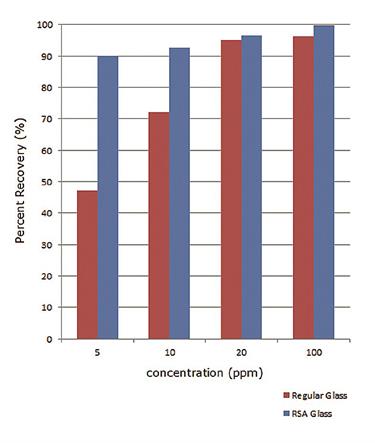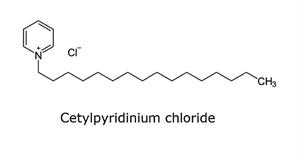Basic compound concentration and adsorption study in autosampler vials - AppNote
November 26, 2013
/
/
/
/
/
/
Comparing cetylpyridinium chloride adsorption on RSA glass v. standard autosampler vials
In this study, the importance of analyte concentration is demonstrated when dealing with adsorption during analyses of basic solutes. Using conventional glass of an industry leading supplier, the basic test analyte cetylpyridinium chloride showed notable loss to adsorption with the vial at the lower concentrations.
If this trend continues to even lower concentrations, the analyte may not even be detected at all. This could have serious implications for analyses that depend on the presence or absence of a given compound, such as pharmaceutical stability testing assays. On the other hand, recovery using RSA vials remained above 90% under the conditions studied.

 Method Conditions
Method Conditions
Tested Item: RSA™, Glass Vials and AQR™ Screw Caps
Specifications: Reduced Surface Activity Glass, Clear, 2ml, Write On, Screw Top Vials and Screw Caps
Catalog No.: 9509S-1WCP-RS
Column: Cogent Diamond Hydride™, 4μm, 100Å
Catalog No.: 70000-7.5P
Mobile Phase: 50:50 DI Water / Acetonitrile with 0.1% Formic Acid
Flow rate: 1.0mL / minute
Sample Preparation: 5.0–100ppm cetylpyridinium chloride reference standards in DI water diluent. Portions of the same samples were transferred to the two vial types and injected into an HPLC initially and after four hours. Peak areas were recorded and compared to initial injections to calculate percent recovery.
Note: Concentration studies are important to any laboratory that deals with trace-level compounds. Advances in analytical detection technology can now observe lower levels than ever before, but this capability is useless if the analyte is lost to adsorption with the autosampler vial before it even enters the instrument.

Attachment
Basic compound concentration and adsorption study in autosampler vials pdf Download File
In this study, the importance of analyte concentration is demonstrated when dealing with adsorption during analyses of basic solutes. Using conventional glass of an industry leading supplier, the basic test analyte cetylpyridinium chloride showed notable loss to adsorption with the vial at the lower concentrations.
If this trend continues to even lower concentrations, the analyte may not even be detected at all. This could have serious implications for analyses that depend on the presence or absence of a given compound, such as pharmaceutical stability testing assays. On the other hand, recovery using RSA vials remained above 90% under the conditions studied.

 Method Conditions
Method Conditions
Tested Item: RSA™, Glass Vials and AQR™ Screw Caps
Specifications: Reduced Surface Activity Glass, Clear, 2ml, Write On, Screw Top Vials and Screw Caps
Catalog No.: 9509S-1WCP-RS
Column: Cogent Diamond Hydride™, 4μm, 100Å
Catalog No.: 70000-7.5P
Mobile Phase: 50:50 DI Water / Acetonitrile with 0.1% Formic Acid
Flow rate: 1.0mL / minute
Sample Preparation: 5.0–100ppm cetylpyridinium chloride reference standards in DI water diluent. Portions of the same samples were transferred to the two vial types and injected into an HPLC initially and after four hours. Peak areas were recorded and compared to initial injections to calculate percent recovery.
Note: Concentration studies are important to any laboratory that deals with trace-level compounds. Advances in analytical detection technology can now observe lower levels than ever before, but this capability is useless if the analyte is lost to adsorption with the autosampler vial before it even enters the instrument.

Attachment
Basic compound concentration and adsorption study in autosampler vials pdf Download File
